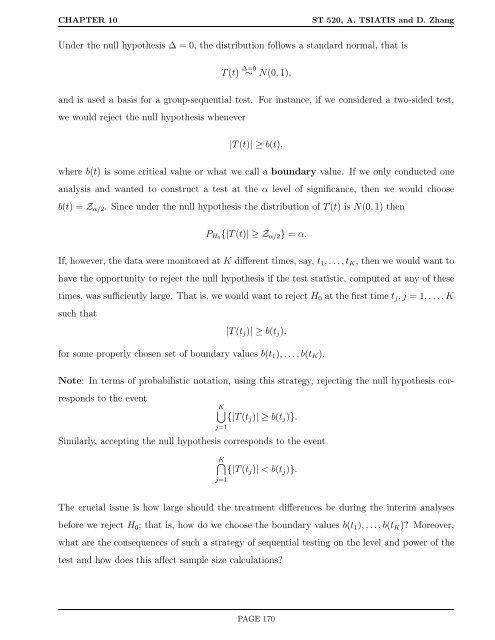ST 520 Statistical Principles of Clinical Trials - NCSU Statistics ...
ST 520 Statistical Principles of Clinical Trials - NCSU Statistics ...
ST 520 Statistical Principles of Clinical Trials - NCSU Statistics ...
You also want an ePaper? Increase the reach of your titles
YUMPU automatically turns print PDFs into web optimized ePapers that Google loves.
CHAPTER 10 <strong>ST</strong> <strong>520</strong>, A. TSIATIS and D. Zhang<br />
Under the null hypothesis ∆ = 0, the distribution follows a standard normal, that is<br />
T(t) ∆=0<br />
∼ N(0, 1),<br />
and is used a basis for a group-sequential test. For instance, if we considered a two-sided test,<br />
we would reject the null hypothesis whenever<br />
|T(t)| ≥ b(t),<br />
where b(t) is some critical value or what we call a boundary value. If we only conducted one<br />
analysis and wanted to construct a test at the α level <strong>of</strong> significance, then we would choose<br />
b(t) = Zα/2. Since under the null hypothesis the distribution <strong>of</strong> T(t) is N(0, 1) then<br />
PH0{|T(t)| ≥ Zα/2} = α.<br />
If, however, the data were monitored at K different times, say, t1, . . .,tK, then we would want to<br />
have the opportunity to reject the null hypothesis if the test statistic, computed at any <strong>of</strong> these<br />
times, was sufficiently large. That is, we would want to reject H0 at the first time tj, j = 1, . . ., K<br />
such that<br />
|T(tj)| ≥ b(tj),<br />
for some properly chosen set <strong>of</strong> boundary values b(t1), . . ., b(tK).<br />
Note: In terms <strong>of</strong> probabilistic notation, using this strategy, rejecting the null hypothesis cor-<br />
responds to the event<br />
K�<br />
{|T(tj)| ≥ b(tj)}.<br />
j=1<br />
Similarly, accepting the null hypothesis corresponds to the event<br />
K�<br />
{|T(tj)| < b(tj)}.<br />
j=1<br />
The crucial issue is how large should the treatment differences be during the interim analyses<br />
before we reject H0; that is, how do we choose the boundary values b(t1), . . .,b(tK)? Moreover,<br />
what are the consequences <strong>of</strong> such a strategy <strong>of</strong> sequential testing on the level and power <strong>of</strong> the<br />
test and how does this affect sample size calculations?<br />
PAGE 170
















